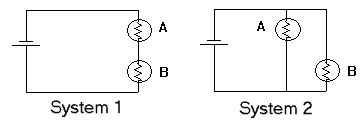
Teaching Physics with the Physics Suite
Home | Action Research Kit| Sample Problems | Resources | Product Information
Problems Sorted by Type | Problems Sorted by Subject | Problems Sorted by Chapter in UP
 |
Teaching Physics with the Physics Suite
Home | Action Research Kit| Sample Problems | Resources | Product Information |
Problems Sorted by Type | Problems Sorted by Subject | Problems Sorted by Chapter in UP |
| Consider the two arrangements of batteries and bulbs shown at the right. All four bulbs are identical and have resistance R. The two batteries are identical and maintain a potential difference (EMF) = E. Answer the following questions and explain why you believe your answer. (Most bulbs are brighter when there is more current through them. Assume that is the case for these bulbs.)
|  |
Not finding what you wanted? Check the Site Map for more information.
Page last modified October 16, 2002: E06